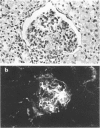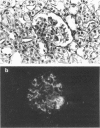Abstract
Depletion of B cells in mice bearing the lymphoproliferation (lpr) gene reduces lymphoproliferation and polyclonal B cell activation (PBA) and attenuates mononuclear cell vasculitis. We sought to verify whether the obverse was true, i.e. whether enhancement of B cell activity might exacerbate the nephritis of MRL/lpr (MRL) mice, a lupus-prone strain. The experimental approach was designed to address three questions: whether naturally occurring PBA in MRL mice could be further enhanced; whether enhanced PBA would exacerbate nephritis; and whether the mechanism of nephritis exacerbation involved interference with mononuclear phagocyte system (MPS) function. To enhance B cell activity, we injected MRL mice with lipopolysaccharide (LPS) from Gram-negative bacteria, a potent B cell activator. To determine whether nephritis was exacerbated, we performed immunopathologic studies and tests of renal function. To verify whether nephritis exacerbation involved impairment of MPS function, we probed the kinetics of immune complex removal from the circulation, their uptake by the liver and spleen, and their localization in kidney tissue. The results indicate that in MRL mice: (i) spontaneous PBA can be enhanced by LPS; (ii) enhancement of PBA by LPS exacerbates nephritis; and (iii) the MPS is already saturated, presumably due to excessive production of endogenous immune complexes. Thus, further increase in immune complex formation due to enhanced PBA by LPS results in increased localization of immune complexes in kidneys and exacerbated nephritis.
Full text
PDF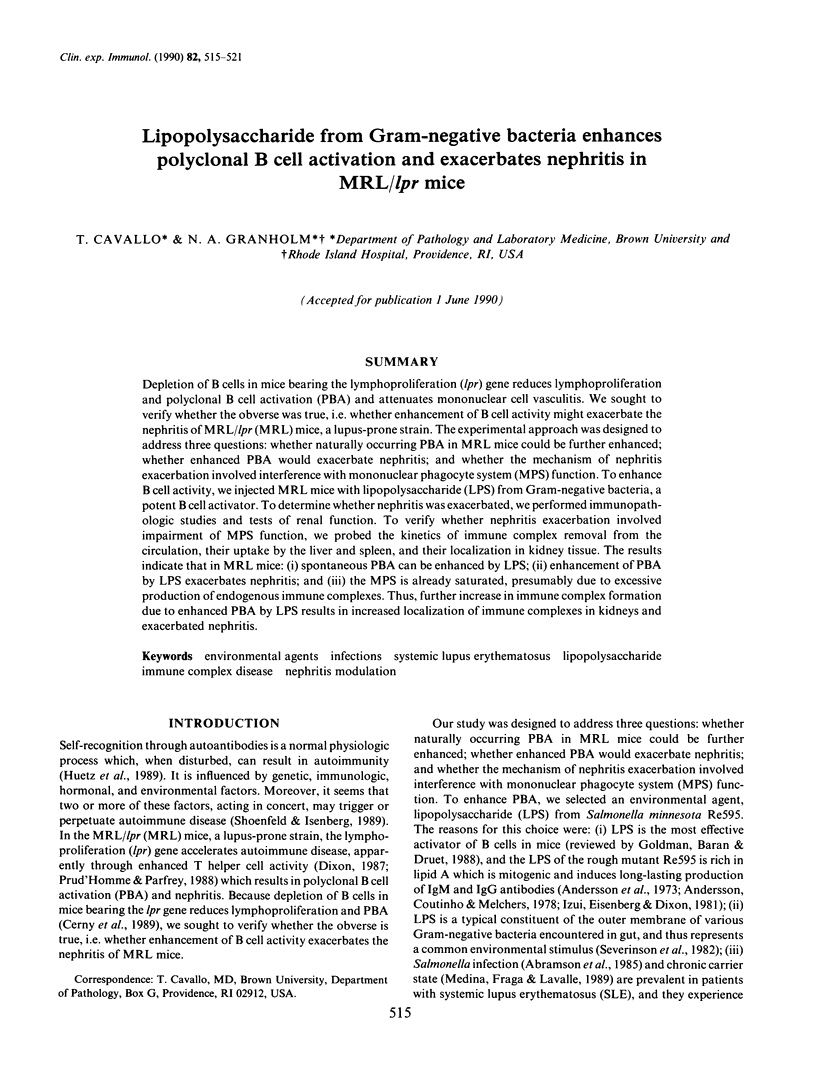


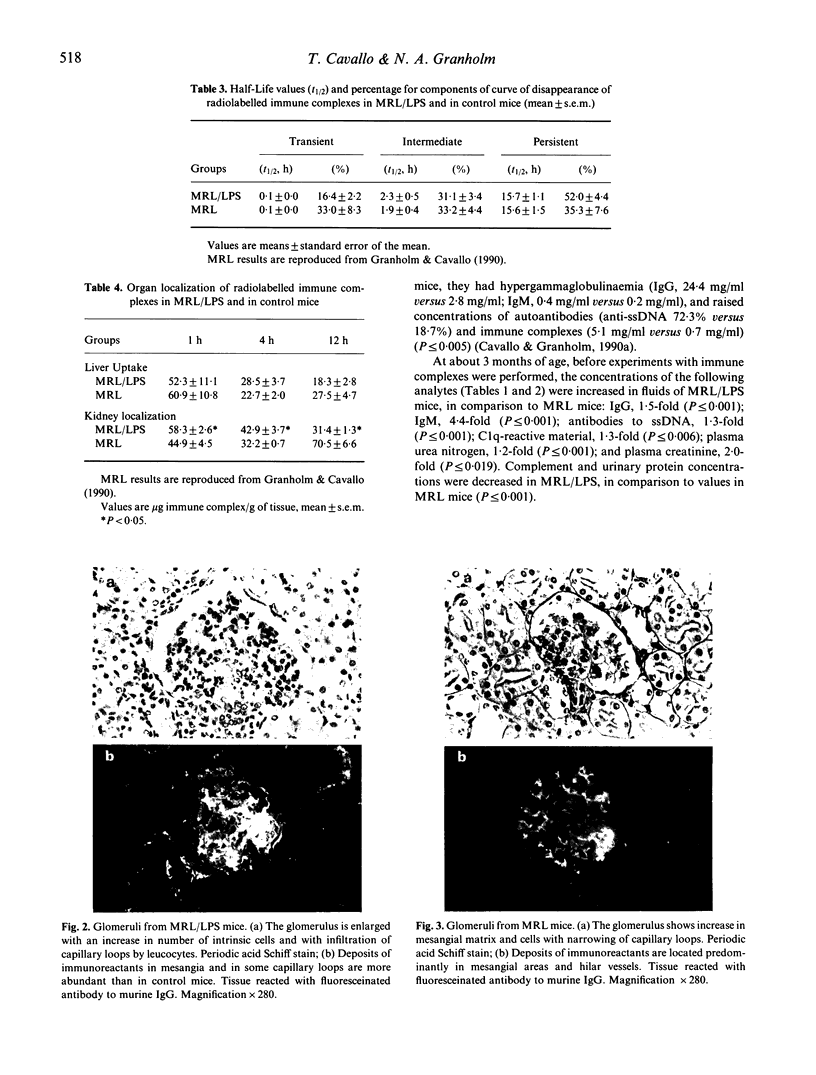
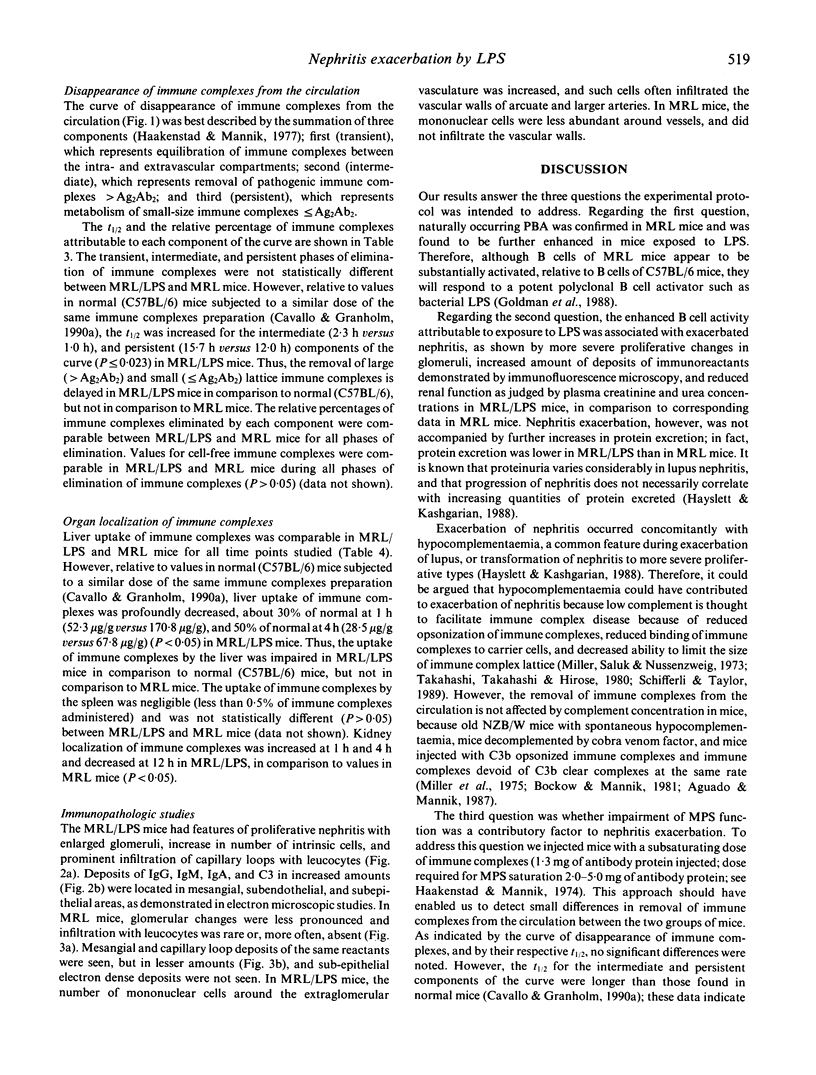
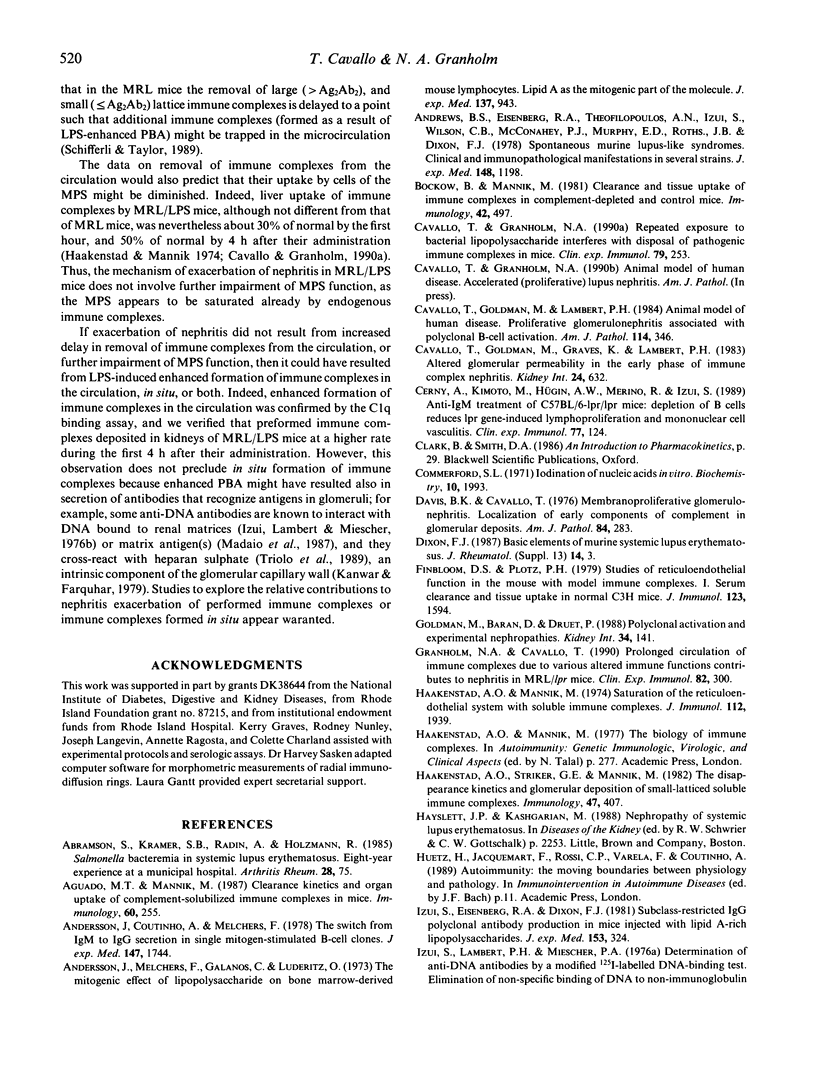

Images in this article
Selected References
These references are in PubMed. This may not be the complete list of references from this article.
- Abramson S., Kramer S. B., Radin A., Holzman R. Salmonella bacteremia in systemic lupus erythematosus. Eight-year experience at a municipal hospital. Arthritis Rheum. 1985 Jan;28(1):75–79. doi: 10.1002/art.1780280112. [DOI] [PubMed] [Google Scholar]
- Aguado M. T., Mannik M. Clearance kinetics and organ uptake of complement-solubilized immune complexes in mice. Immunology. 1987 Feb;60(2):255–260. [PMC free article] [PubMed] [Google Scholar]
- Andersson J., Coutinho A., Melchers F. The switch from IgM to IgG secretion in single mitogen-stimulated B-cell clones. J Exp Med. 1978 Jun 1;147(6):1744–1754. doi: 10.1084/jem.147.6.1744. [DOI] [PMC free article] [PubMed] [Google Scholar]
- Andersson J., Melchers F., Galanos C., Lüderitz O. The mitogenic effect of lipopolysaccharide on bone marrow-derived mouse lymphocytes. Lipid A as the mitogenic part of the molecule. J Exp Med. 1973 Apr 1;137(4):943–953. doi: 10.1084/jem.137.4.943. [DOI] [PMC free article] [PubMed] [Google Scholar]
- Andrews B. S., Eisenberg R. A., Theofilopoulos A. N., Izui S., Wilson C. B., McConahey P. J., Murphy E. D., Roths J. B., Dixon F. J. Spontaneous murine lupus-like syndromes. Clinical and immunopathological manifestations in several strains. J Exp Med. 1978 Nov 1;148(5):1198–1215. doi: 10.1084/jem.148.5.1198. [DOI] [PMC free article] [PubMed] [Google Scholar]
- Bockow B., Mannik M. Clearance and tissue uptake of immune complexes in complement-depleted and control mice. Immunology. 1981 Apr;42(4):497–504. [PMC free article] [PubMed] [Google Scholar]
- Cavallo T., Goldman M., Graves K., Lambert P. H. Altered glomerular permeability in the early phase of immune complex nephritis. Kidney Int. 1983 Nov;24(5):632–637. doi: 10.1038/ki.1983.204. [DOI] [PubMed] [Google Scholar]
- Cavallo T., Goldman M., Lambert P. H. Animal model of human disease. Proliferative glomerulonephritis associated with polyclonal B-cell activation. Am J Pathol. 1984 Feb;114(2):346–348. [PMC free article] [PubMed] [Google Scholar]
- Cavallo T., Granholm N. A. Repeated exposure to bacterial lipopolysaccharide interferes with disposal of pathogenic immune complexes in mice. Clin Exp Immunol. 1990 Feb;79(2):253–259. doi: 10.1111/j.1365-2249.1990.tb05187.x. [DOI] [PMC free article] [PubMed] [Google Scholar]
- Cerny A., Kimoto M., Hügin A. W., Merino R., Izui S. Anti-IgM treatment of C57BL/6-1pr/1pr mice: depletion of B cells reduces 1pr gene-induced lymphoproliferation and mononuclear cell vasculitis. Clin Exp Immunol. 1989 Jul;77(1):124–129. [PMC free article] [PubMed] [Google Scholar]
- Commerford S. L. Iodination of nucleic acids in vitro. Biochemistry. 1971 May 25;10(11):1993–2000. doi: 10.1021/bi00787a005. [DOI] [PubMed] [Google Scholar]
- Davis B. K., Cavallo T. Membranoproliferative glomerulonephritis. Localization of early components of complement in glomerular deposits. Am J Pathol. 1976 Aug;84(2):283–298. [PMC free article] [PubMed] [Google Scholar]
- Finbloom D. S., Plotz P. H. Studies of reticuloendothelial function in the mouse with model immune complexes. I. Serum clearance and tissue uptake in normal C3H mice. J Immunol. 1979 Oct;123(4):1594–1599. [PubMed] [Google Scholar]
- Goldman M., Baran D., Druet P. Polyclonal activation and experimental nephropathies. Kidney Int. 1988 Aug;34(2):141–150. doi: 10.1038/ki.1988.159. [DOI] [PubMed] [Google Scholar]
- Granholm N. A., Cavallo T. Prolonged circulation of immune complexes due to various altered immune functions contributes to nephritis in MRL/lpr mice. Clin Exp Immunol. 1990 Nov;82(2):300–306. doi: 10.1111/j.1365-2249.1990.tb05443.x. [DOI] [PMC free article] [PubMed] [Google Scholar]
- Haakenstad A. O., Mannik M. Saturation of the reticuloendothelial system with soluble immune complexes. J Immunol. 1974 May;112(5):1939–1948. [PubMed] [Google Scholar]
- Haakenstad A. O., Striker G. E., Mannik M. The disappearance kinetics and glomerular deposition of small-latticed soluble immune complexes. Immunology. 1982 Nov;47(3):407–414. [PMC free article] [PubMed] [Google Scholar]
- Izui S., Eisenberg R. A., Dixon F. J. Subclass-restricted IgG polyclonal antibody production in mice injected with lipid A-rich lipopolysaccharides. J Exp Med. 1981 Feb 1;153(2):324–338. doi: 10.1084/jem.153.2.324. [DOI] [PMC free article] [PubMed] [Google Scholar]
- Izui S., Lambert P. H., Miescher P. A. Determination of anti-DNA antibodies by a modified 125I-labelled DNA-binding test. Elimination of non-specific binding of DNA to non-immunoglobulin basic proteins by using an anionic detergent. Clin Exp Immunol. 1976 Dec;26(3):425–430. [PMC free article] [PubMed] [Google Scholar]
- Izui S., Lambert P. H., Miescher P. A. In vitro demonstration of a particular affinity of glomerular basement membrane and collagen for DNA. A possible basis for a local formation of DNA-anti-DNA complexes in systemic lupus erythematosus. J Exp Med. 1976 Aug 1;144(2):428–443. doi: 10.1084/jem.144.2.428. [DOI] [PMC free article] [PubMed] [Google Scholar]
- Kanwar Y. S., Farquhar M. G. Presence of heparan sulfate in the glomerular basement membrane. Proc Natl Acad Sci U S A. 1979 Mar;76(3):1303–1307. doi: 10.1073/pnas.76.3.1303. [DOI] [PMC free article] [PubMed] [Google Scholar]
- LOWRY O. H., ROSEBROUGH N. J., FARR A. L., RANDALL R. J. Protein measurement with the Folin phenol reagent. J Biol Chem. 1951 Nov;193(1):265–275. [PubMed] [Google Scholar]
- Madaio M. P., Carlson J., Cataldo J., Ucci A., Migliorini P., Pankewycz O. Murine monoclonal anti-DNA antibodies bind directly to glomerular antigens and form immune deposits. J Immunol. 1987 May 1;138(9):2883–2889. [PubMed] [Google Scholar]
- Mancini G., Carbonara A. O., Heremans J. F. Immunochemical quantitation of antigens by single radial immunodiffusion. Immunochemistry. 1965 Sep;2(3):235–254. doi: 10.1016/0019-2791(65)90004-2. [DOI] [PubMed] [Google Scholar]
- Mannik M., Arend M. P., Hall A. P., Gilliland B. C. Studies on antigen-antibody complexes. I. Elimination of soluble complexes from rabbit circulation. J Exp Med. 1971 Apr 1;133(4):713–739. doi: 10.1084/jem.133.4.713. [DOI] [PMC free article] [PubMed] [Google Scholar]
- Marchalonis J. J. An enzymic method for the trace iodination of immunoglobulins and other proteins. Biochem J. 1969 Jun;113(2):299–305. doi: 10.1042/bj1130299. [DOI] [PMC free article] [PubMed] [Google Scholar]
- Medina F., Fraga A., Lavalle C. Salmonella septic arthritis in systemic lupus erythematosus. The importance of chronic carrier state. J Rheumatol. 1989 Feb;16(2):203–208. [PubMed] [Google Scholar]
- Miller G. W., Saluk P. H., Nussenzweig V. Complement-dependent release of immune complexes from the lymphocyte membrane. J Exp Med. 1973 Sep 1;138(3):495–507. doi: 10.1084/jem.138.3.495. [DOI] [PMC free article] [PubMed] [Google Scholar]
- Miller G. W., Steinberg A. D., Green I., Nussenzweig V. Complement-dependent alterations in the handling of immune complexes by NZB/W mice. J Immunol. 1975 Apr;114(4):1166–1170. [PubMed] [Google Scholar]
- Pesce A. J. Methods used for the analysis of proteins in the urine. Nephron. 1974;13(1):93–104. doi: 10.1159/000180371. [DOI] [PubMed] [Google Scholar]
- Prud'homme G. J., Parfrey N. A. Role of T helper lymphocytes in autoimmune diseases. Lab Invest. 1988 Aug;59(2):158–172. [PubMed] [Google Scholar]
- Schifferli J. A., Taylor R. P. Physiological and pathological aspects of circulating immune complexes. Kidney Int. 1989 Apr;35(4):993–1003. doi: 10.1038/ki.1989.83. [DOI] [PubMed] [Google Scholar]
- Severinson E., Bergstedt-Lindqvist S., van der Loo W., Fernandez C. Characterization of the IgG response induced by polyclonal B cell activators. Immunol Rev. 1982;67:73–85. doi: 10.1111/j.1600-065x.1982.tb01056.x. [DOI] [PubMed] [Google Scholar]
- Shoenfeld Y., Isenberg D. A. The mosaic of autoimmunity. Immunol Today. 1989 Apr;10(4):123–126. doi: 10.1016/0167-5699(89)90245-4. [DOI] [PubMed] [Google Scholar]
- Takahashi M., Takahashi S., Hirose S. Solubilization of antigen-antibody complexes: a new function of complement as a regulator of immune reactions. Prog Allergy. 1980;27:134–166. [PubMed] [Google Scholar]
- Triolo G., Giardina E., Scarantino G., Seddio G., Cardella F., Meli F., Bompiani G. Cross-reactivity of anti-ssDNA antibodies with heparan sulfate in patients with type I diabetes mellitus. Diabetes. 1989 Jun;38(6):718–722. doi: 10.2337/diab.38.6.718. [DOI] [PubMed] [Google Scholar]
- Zubler R. H., Lange G., Lambert P. H., Miescher P. A. Detection of immune complexes in unheated sera by modified 125I-Clq binding test. Effect of heating on the binding of Clq by immune complexes and application of the test to systemic lupus erythematosus. J Immunol. 1976 Jan;116(1):232–235. [PubMed] [Google Scholar]



